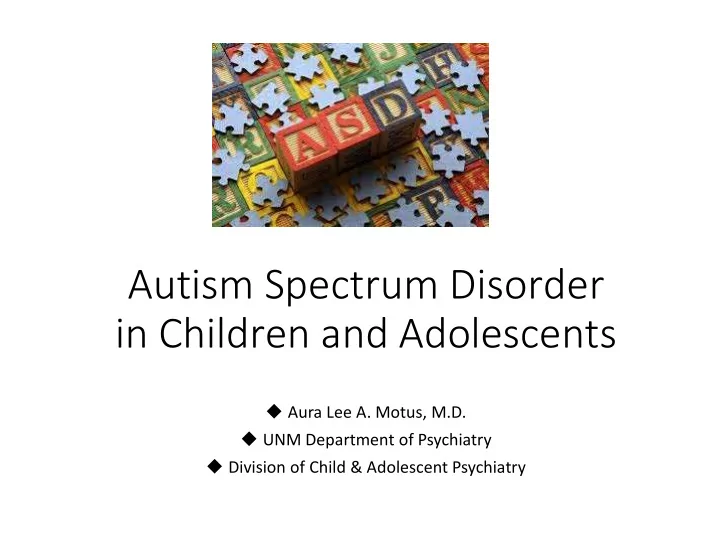

Autism Spectrum Disorder in Child ren and Adolescents Aura Lee A. Motus, M.D. UNM Department of Psychiatry Division of Child & Adolescent Psychiatry
OBJECTIVES • Recognize Early Signs of ASD • Review Methods of Assessments • Discuss Treatment Options
Autism Spectrum Disorder • Neurodevelopmental disability that can cause significant social, communication and behavioral challenges
Three Core Features of ASD • Impairments in communication • Impairments in social interaction • Restrictive, repetitive Patterns
Early Signs • No big smiles or other warm, joyful expressions by 6mos or thereafter • No back-and-forth sharing of sounds, smiles or other facial expressions by nine months • No babbling by 12 months
Early Signs • No back-and-forth gestures such as pointing, showing, reaching or waving by 12 months • No words by 16 months • No meaningful, two-word phrases (not including imitating or repeating) by 24 months • Any loss of speech, babbling or social skills at any age
Social Differences in Children with Autism • Doesn't keep eye contact or makes very little eye contact • Doesn't respond to a parent's smile or other facial expressions • Doesn't look at objects or events a parent is looking at or pointing to • Doesn't point to objects or events to get a parent to look at them
Social Differences in Children with Autism • Doesn't bring objects of personal interest to show to a parent • Doesn't often have appropriate facial expressions • Unable to perceive what others might be thinking or feeling by looking at their facial expressions • Doesn't show concern for others • Unable to make friends or uninterested in making friends
Communication Differences in Children with Autism • Doesn't point at things to indicate needs or share things with others • Doesn't say single words by 16 months • Repeats exactly what others say without understanding the meaning • Doesn't respond to name being called but does respond to other sounds • Refers to self as "you" and others as "I" and may mix up pronouns
Communication Differences in Children with Autism • Often doesn't seem to want to communicate • Doesn't start or can't continue a conversation • Doesn't use toys or other objects to represent people or real life in pretend play • May have a good memory, especially for numbers, letters, songs, TV jingles, or a specific topic • May lose language or other social milestones
Behavioral Differences in Children with Autism • Rocks, spins, sways, twirls fingers, walks on toes for a long time, or flaps hands • Likes routines, order, and rituals; has difficulty with change • Obsessed with a few or unusual activities, doing them repeatedly during the day • Plays with parts of toys instead of the whole toy
Behavioral Differences in Children with Autism • Doesn't seem to feel pain • May be very sensitive or not sensitive at all to smells, sounds, lights, textures, and touch • Unusual use of vision or gaze—looks at objects from unusual angles
Methods of Assessments • SCREENING TOOLS • Ages and Stages Questionnaires (ASQ) • Modified Checklist for Autism in Toddlers (MCHAT) • Communication and Symbolic Behavior Scales (CSBS) • Parents’ Evaluation of Developmental Status (PEDS) • Screening tool for Autism in Toddlers and Young Children (STAT)
Methods of Assessments • DIAGNOSTIC TOOLS • Autism Diagnosis Interview-Revised (ADI-R) • Autism Diagnostic Observation Schedule (ADOS) • Childhood Autism Rating Scale (CARS) • Gilliam Autism Rating Scale- Second Edition (GARS-2)
Treatment Options • Early Intervention Services • helps children from birth to 3 years old (36 months) learn important skills. Services include therapy to help the child talk, walk, and interact with others
Types of Treatments • Behavior and Communication Approaches • Dietary Approaches • Medication • Complementary and Alternative Medicine
Behavior and Communication Approaches • Applied Behavior Analysis • Types • Discrete Trial Training (DTT) • Early Intensive Behavioral Intervention (EIBI) • Pivotal Response Training (PRT) • Verbal Behavior Intervention (VBI)
Behavior and Communication Approaches • Developmental, Individual Differences, Relationship Based Approach (DIR) • Treatment and Education of Autistic and related Communication- Handicapped Children (TEACCH) • Occupational therapy • Sensory Integration Therapy • Speech therapy • The Picture Exchange Communication System (PECS)
Dietary Approaches • Special Diets • Gluten Free Casein free Diet • Exclusion of Phenolic Compounds and foods High in Salicylates • Exclusion of Food Additives • Yeast Free Diet • Supplements • Fish Oils and other supplements rich in Omega 3 Fats • Probiotics and Enzymes
Medications
Complementary and Alternative Treatment • Types include: • Special diets • Chelation • Biologicals • Body based systems
Recommend
More recommend